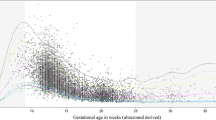Abstract
In an attempt to track the proliferation/demise of trophoblastic tissues in women following gamete transfer (GT) or in vitro fertilization/embryo transfer (IVF/ET), we have measured levels of human chorionic gonadotropin (hCG) in serum of 180 patients on days 7 and 14 following oocyte pickup (OPU). Serum hCG levels were measured by immunoassay and by a bioassay based on the capacity of the sample to stimulate testosterone secretion by cultured mouse Leydig cells. Based on determinations of bioactive and immunoactive hCG in serum from 18 of 180 patients who subsequently delivered (12 of 73 GT, 6 of 107 IVF/ET;P<0.05) and classification of patients in accord with their compliance or noncompliance with these ranges of values, about 70% of all patients in the present study were classified as “pregnant” 7 days following OPU. Based on these same criteria, about 23% were pregnant 7 days later. Biochemical pregnancy rates on days 7 and 14 following GT (near 73 and 27%, respectively) were not different from the respective values following IVF/ET (near 68 and 20%, respectively:P>0.05). The luteotropin bioassay described is highly sensitive to hCG (to 0.02 mIU/ml serum) and appears appropriate to the characterization of proliferation/demise of embryonic tissues during the 14 days after gamete/embryo transfer. In addition, through its representation of the cumulative luteotropic properties of human serum and its insensitivity to biologically inactive hCG subunits; this bioassay appears more appropriate than hCG immunoassay in the monitoring of early embryonic signalling following assisted (or spontaneous) conception in the woman.
Similar content being viewed by others
References
Hertig AT, Rock J, Adams EC, Menkin AC: Thirty-four fertilized human ova, good, bad and indifferent, recovered from 210 women of known fertility. Pediatrics 1952;23:202–211
Miller JF, Williamson E, Glue J, Gordon YB, Grudzinskas JG, Sykes A: Fetal loss after implantation. A prospective study. Lancet 1980;Sept 13:553–556
Faulk WP, McIntyre JA: Trophoblast survival. Transplantation 1981;32:1–5
Edmonds DK, Lindsay KS, Miller JF, Williamson E, Wood PJ: Early embryonic mortality in women. Fertil Steril 1982;38:447–453
Roberts CJ, Lowe CR: Where have all the conceptions gone. Lancet 1975; Mar 1:498–499
Lenton EA, Osborn J, Fothergill D, Cooke ID: Early pregnancy loss in normal women and following IVF. Proceedings of the Fifth World Congress on in Vitro Fertilization and Embryo Transfer, 1987, Abstr PS-047
Seegar Jones G: Update on in vitro fertilization. Endocrine Rev 1984;5:62–75
Chang SP, Shoupe D, Kletzky OA, Lobo RA: Differences in the ratio of bioactive to immunoreactive serum luteinizing hormone during vasomotor flushes and hormonal therapy in postmenopausal woman. J Clin Endocrinol Metab 1984; 58:925–929
Lichtenberg V, Weise HC, Graesslin D, Bettendorf G: Polymorphism of human pituitary lutropin (LH). Effect of seven isohormones on mouse Leydig cell functions. FEBS Lett 1984;169:21–24
Robertson WR, Lambert A, Loveridge N: The role of modern bioassays in clinical endocrinology. Clin Endocrinol 1987;27:259–278
Fishel SB: Uterine histology, biochemistry and secretions.In Implantation of the Human Embryo, RG Edwards, Jean M Purdy, PC Steptoe (eds). London, Academic Press, 1985, pp 47–63
Snedecor GW, Cochran WG: Statistical Methods. Ames, Iowa State University Press, 1980
Clarke GM: Statistics and Experimental Design. London, Edward Arnold, 1969, pp 52–57
Manjunath P, Sairam MR: Biochemical, biological, and immunological properties of chemically deglycosylated human chorio-gonadotropin. J Biol Chem 1982;257:7109–7115
Chen H-C, Shimohigashi Y, Dufau ML, Catt KJ: Characterization and biological properties of chemically deglycosylated human chorionic gonadotropin: Role of carbohydrate moieties in adenylate cyclase activation. J Biol Chem 1982;257:14446–14452
Yen SSC, Llerena O, Little B, Pearson OH: Disapperance rates of endogenous luteinizing hormone and chorionic gonadotropin in man. J Clin Endocrinol Metab 1968;28:1763–1767
Edwards RG: Conception in the Human Female. London, Academic Press, 1980
Fishel SB, Edwards RG, Evans CJ: Human chorionic gonadotropin secreted by preimplantation embryos cultured in vitro. Science 1984;223:816–818
Dickmann Z, Dey SK, Sen Gupta J: A new concept: Control of early pregnancy by steroid hormones originating in the pre-implantation embryo. Vit Horm 1976;34:215–242
Poyser NL, Maule Walker FM: Antiluteolytic effect of the embryo.In Maternal Recognition of Pregnancy, Ciba Foundation Symposium 64 (New Series). Amsterdam, Excerpta Medica, 1979, pp 261–292
Basha SMM, Bazer FW, Roberts RM: Effect of conceptus on quantitative and qualitative aspects of uterine secretion in pigs. J Reprod Fertil 1980;60:41–48
Stone BA, Seamark RF, Kelly RW, Deam S: Production of steroids and release of prostaglandins by spherical pig blastocysts in vitro. Aust J Biol Sci 1986;39:283–293
Author information
Authors and Affiliations
Rights and permissions
About this article
Cite this article
Stone, B.A., Tan, T.T., Boopersmith, T.B. et al. Luteotropic activity in serum of women following embryo or gamete transfer in a program of assisted conception. J Assist Reprod Genet 5, 275–281 (1988). https://doi.org/10.1007/BF01132177
Received:
Accepted:
Issue Date:
DOI: https://doi.org/10.1007/BF01132177




